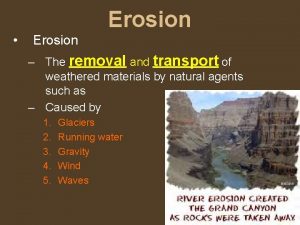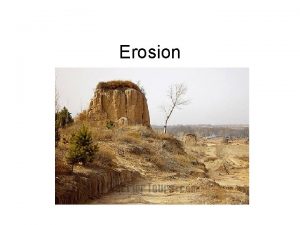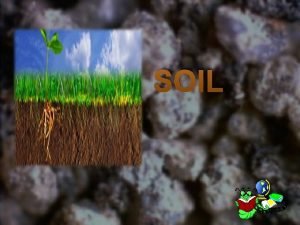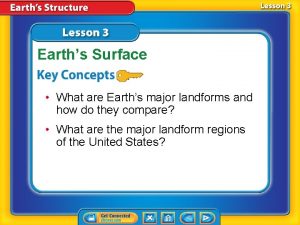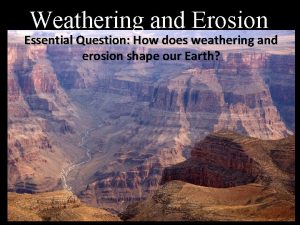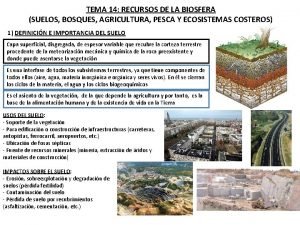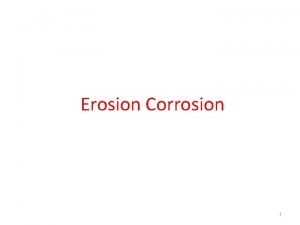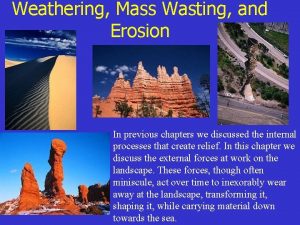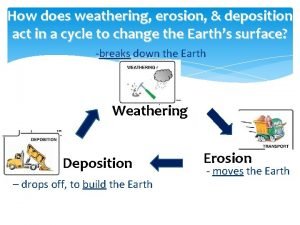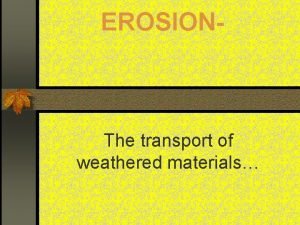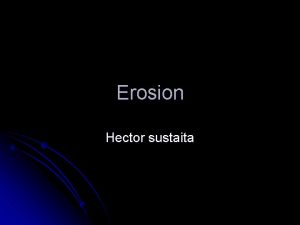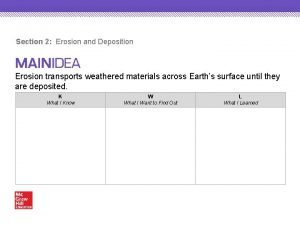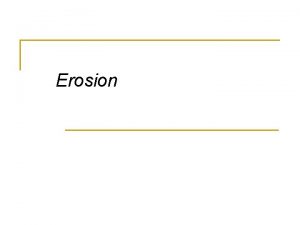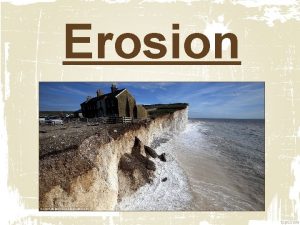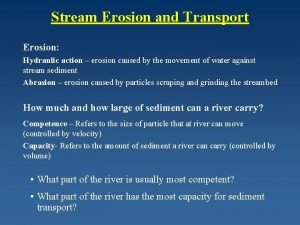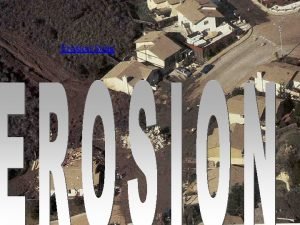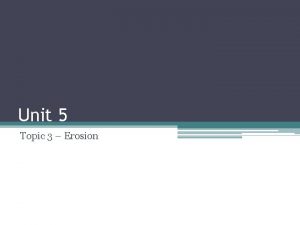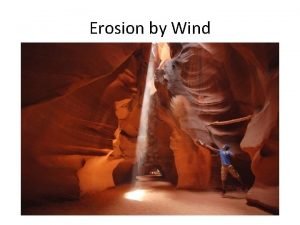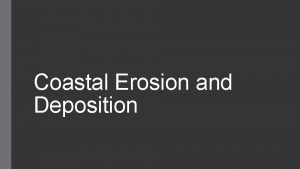EROSION The transport of weathered materials Major Erosive






































































- Slides: 70

EROSION- The transport of weathered materials…


Major Erosive Agents: n Running Water n GLACIERS n WIND n OCEAN CURRENTS AND WAVES n MASS WASTING (GRAVITY!)

EROSION by gravity n Also known as MASS MOVEMENT n. Avalanches or rock falls n. Land or Mud Slides n. Slump or Flows n. Creep

1995 Landslide in La Conchita, CA.

The two forces involved in all mass movements are GRAVITY (pulling the material down) and FRICTION (keeping the material in place). Typically excessive amounts of water lessen the force of friction and lead to a landslide.

New York City’s Henry Hudson Parkway in Upper Manhattan A 75 foot retaining wall collapsed on May 12 th, 2005.

Running water move more sediment than any other agent of erosion.

What happens to rainfall when it hits earth? ? n Some evaporates n Some is absorbed and becomes ground water n Some is run off

What determines if rainwater becomes runoff or groundwater? Ground Conditions: n Saturated vs. unsaturated n Vegetation – amount of plants n Slope or Gradient of the Land

Running Water – Most of North America is above sea level. Water flows high to low sea level due to gravity

When Runoff becomes confined to a channel – Stream Exists

Watersheds or Drainage Basins n Smaller stream that flows into a larger stream is called a tributary n Tributaries and land that contribute to the stream is called a drainage basin or watershed (COMPARED TO A BATHTUB. WATER THAT COLLECTS IN A BATHTUB FLOWS TOWARD THE DRAIN. ) n The drainage basin of one stream is separated by a drainage divide (ridges or mountains – higher elevations)

HOW WATERSHEDS/DRAINAGE BASINS FORM – RED LINE IS DRAINAGE DIVIDE

Watersheds: Continental Divide and Appalachian Mountains Water goes from high sea level to low sea level

Watershed Regions of New York State

3 factors affecting Stream Velocity q Gradient – slope of the stream q Discharge – volume of water q Stream channel shape

Stream Velocity in a Straight Channel Fastest – middle just below surface

The velocity changes in the S-shaped curves called MEANDERS. Fastest on the outside of the curve – erosion Slowest on the inside of the curve - deposition

STREAMS CARRY MATERIAL IN … n Solution: dissolved material (includes salts) n Suspension: particles carried in the flow of the water (Clay, silt, sand) n Bed load: particles carried by rolling, bouncing, or dragging along the stream bed (Pebbles, cobbles, boulders)


THE GREATER THE VELOCITY OF A STREAM… § THE LARGER THE SEDIMENT PARTICLES IT CAN CARRY § THE MORE TOTAL SEDIMENTS IT CAN CARRY

Water Velocity determines the size particle that can be moved via suspension and bed load

Stream Development – Early Stage n The landscape is continuously being reshaped by stream erosion. Plateaus can be cut by rivers to form canyons. Valleys can be carved in mountains as rivers flow through them. n As the stream begins to down cut into the land – waterfalls and rapids form

Stream Development – Young Stage n V-Shaped Valley n Rapids and Waterfalls n No Flood Plain – a level plain that borders stream

V-SHAPED VALLEY…

RAPIDS AND WATERFALLS n Rapids - Different resistance among rocks cause FAST-FLOWING WATER n Waterfalls – Rapids develop into waterfalls as softer rock erodes



Stream Development - Mature Stage n Lateral erosion widens the valley profile – slope decreases n River meanders pronounced n A FLOOD PLAIN develops

As the stream grows larger – it begins to shift its course in a series of bends or curves called meanders seeking out the lowest elevation



Point Bars show deposition Cut Banks show erosion

Cut bank on outside of curve due to higher velocity of water – more erosion Cut bank on outside of curve Point Bar on inside of curve



Stream Development - Old Age n Very Wide Flood Plain n Land worn down to flat surface n Oxbow Lakes

Stream Development – Old Age

Eventually, it takes too much energy to keep meandering, so rivers will cut off a bend, resulting in an OXBOW lake…





What is the correct sequence in stream development?

Levee Formation

SEDIMENTS ERODED BY RUNNING WATER WILL HAVE THESE CHARACTERISTICS n ROUNDED and SMOOTH n SORTED AND LAYERED


SEDIMENTS ERODED BY RUNNING WATER WILL BE … n SORTED – all materials are about the same size

Contour lines showing head of the stream to the mouth of stream with delta Velocity slows when entering a large body of water

Alluvial fans form when streams come out of mountains onto flat land – velocity slows and deposition occurs

Erosion by Waves and Long shore Current n Where lake or ocean waters meet land, waves and currents act as agents of erosion, creating unique landscape features

Winds at the ocean’s surface cause waves


Longshore Current n Waves are refracted or bent in the shallow water of the shore n Water near the shore is pushed in one direction along the shore – called longshore current Sediments are carried in a zig-zag pattern in the SAME direction as the longshore current





The sand trapping effect of the jetties to the north at Charleston, South Carolina has deprived Morris Island of needed sand. As a result, the island has eroded to the point that this previously land based lighthouse is now 400 meters out to sea.

Which direction is the long shore current carrying sediment? ?

Barrier Islands n Wave Action creates sand bars n Waves and Longshore current - can form barrier islands Ex. Fire Island


Wind Erosion n Sediment – sand or smaller n Arid regions or ocean coastlines n 2 types: 1. Deflation – lowers the land 2. Sandblasting and Abrasion

Sandblasting and Abrasion n Wind can only lift sand to about 1 meter high - results in “Mushroom Rock” n Frosted or Pitted sediments – rocks with flat sides



Windward side Leeward side


 Materials transported due to erosion
Materials transported due to erosion Rill erosion
Rill erosion The process by which natural forces move weathered
The process by which natural forces move weathered Soil is a mixture of weathered rock and ________.
Soil is a mixture of weathered rock and ________. Assonance in o captain my captain
Assonance in o captain my captain What is subsoil
What is subsoil Landforms with low relief and high elevation
Landforms with low relief and high elevation What is the major agent of erosion
What is the major agent of erosion Symport antiport uniport
Symport antiport uniport Unlike passive transport active transport requires
Unlike passive transport active transport requires Primary vs secondary active transport
Primary vs secondary active transport Primary active transport vs secondary active transport
Primary active transport vs secondary active transport Now answer the questions
Now answer the questions Active transport and passive transport
Active transport and passive transport Bioflix activity membrane transport active transport
Bioflix activity membrane transport active transport Active vs passive transport venn diagram
Active vs passive transport venn diagram Isotonic in biology
Isotonic in biology Adopting and adapting teaching materials
Adopting and adapting teaching materials Cant stop the feeling trolls go noodle
Cant stop the feeling trolls go noodle Direct materials budget with multiple materials
Direct materials budget with multiple materials 10 household materials useful and harmful
10 household materials useful and harmful Natural materials and man made materials
Natural materials and man made materials Chụp tư thế worms-breton
Chụp tư thế worms-breton Thế nào là hệ số cao nhất
Thế nào là hệ số cao nhất ưu thế lai là gì
ưu thế lai là gì Hệ hô hấp
Hệ hô hấp Tư thế ngồi viết
Tư thế ngồi viết Cái miệng nó xinh thế chỉ nói điều hay thôi
Cái miệng nó xinh thế chỉ nói điều hay thôi Cách giải mật thư tọa độ
Cách giải mật thư tọa độ Bổ thể
Bổ thể Tư thế ngồi viết
Tư thế ngồi viết Thẻ vin
Thẻ vin Thể thơ truyền thống
Thể thơ truyền thống Alleluia hat len nguoi oi
Alleluia hat len nguoi oi Các châu lục và đại dương trên thế giới
Các châu lục và đại dương trên thế giới Từ ngữ thể hiện lòng nhân hậu
Từ ngữ thể hiện lòng nhân hậu Hổ đẻ mỗi lứa mấy con
Hổ đẻ mỗi lứa mấy con Diễn thế sinh thái là
Diễn thế sinh thái là Vẽ hình chiếu vuông góc của vật thể sau
Vẽ hình chiếu vuông góc của vật thể sau Ví dụ giọng cùng tên
Ví dụ giọng cùng tên 101012 bằng
101012 bằng Tỉ lệ cơ thể trẻ em
Tỉ lệ cơ thể trẻ em Lời thề hippocrates
Lời thề hippocrates đại từ thay thế
đại từ thay thế Quá trình desamine hóa có thể tạo ra
Quá trình desamine hóa có thể tạo ra Các môn thể thao bắt đầu bằng tiếng đua
Các môn thể thao bắt đầu bằng tiếng đua Công thức tiính động năng
Công thức tiính động năng Thế nào là mạng điện lắp đặt kiểu nổi
Thế nào là mạng điện lắp đặt kiểu nổi Hát kết hợp bộ gõ cơ thể
Hát kết hợp bộ gõ cơ thể Các loại đột biến cấu trúc nhiễm sắc thể
Các loại đột biến cấu trúc nhiễm sắc thể Nguyên nhân của sự mỏi cơ sinh 8
Nguyên nhân của sự mỏi cơ sinh 8 Vẽ hình chiếu đứng bằng cạnh của vật thể
Vẽ hình chiếu đứng bằng cạnh của vật thể Phản ứng thế ankan
Phản ứng thế ankan Chó sói
Chó sói Thiếu nhi thế giới liên hoan
Thiếu nhi thế giới liên hoan Khi nào hổ mẹ dạy hổ con săn mồi
Khi nào hổ mẹ dạy hổ con săn mồi điện thế nghỉ
điện thế nghỉ Một số thể thơ truyền thống
Một số thể thơ truyền thống Trời xanh đây là của chúng ta thể thơ
Trời xanh đây là của chúng ta thể thơ Frameset trong html5
Frameset trong html5 Số nguyên tố là số gì
Số nguyên tố là số gì đặc điểm cơ thể của người tối cổ
đặc điểm cơ thể của người tối cổ Tia chieu sa te
Tia chieu sa te Các châu lục và đại dương trên thế giới
Các châu lục và đại dương trên thế giới Los factores formadores del suelo
Los factores formadores del suelo Caustic embrittlement
Caustic embrittlement Wind erosion saltation
Wind erosion saltation What is deposition? *
What is deposition? * Mass wasting
Mass wasting Detachment transportation and deposition
Detachment transportation and deposition Soil erosion and deposition
Soil erosion and deposition
